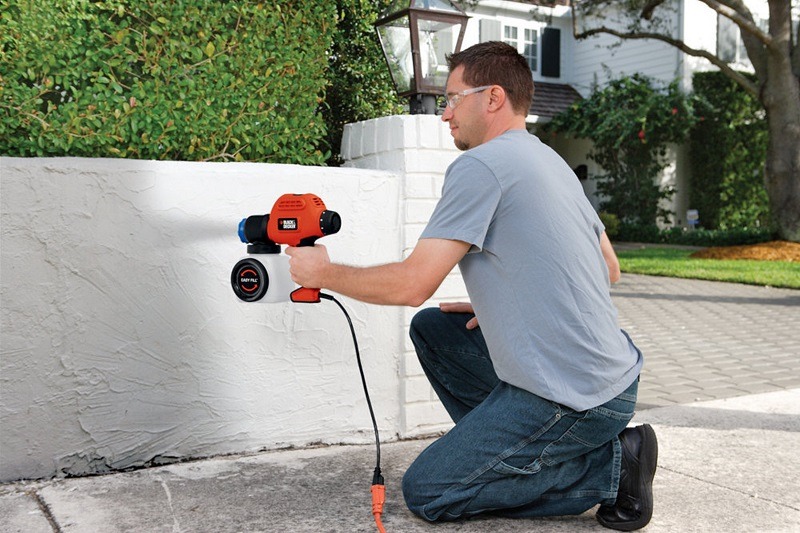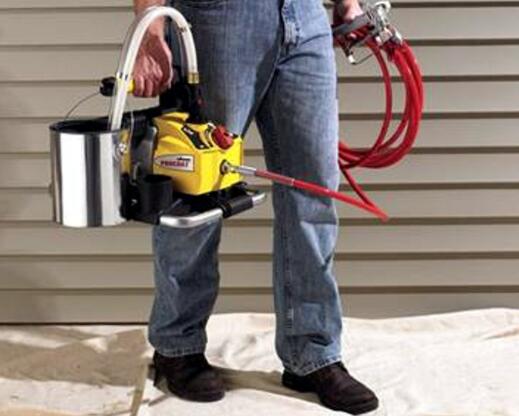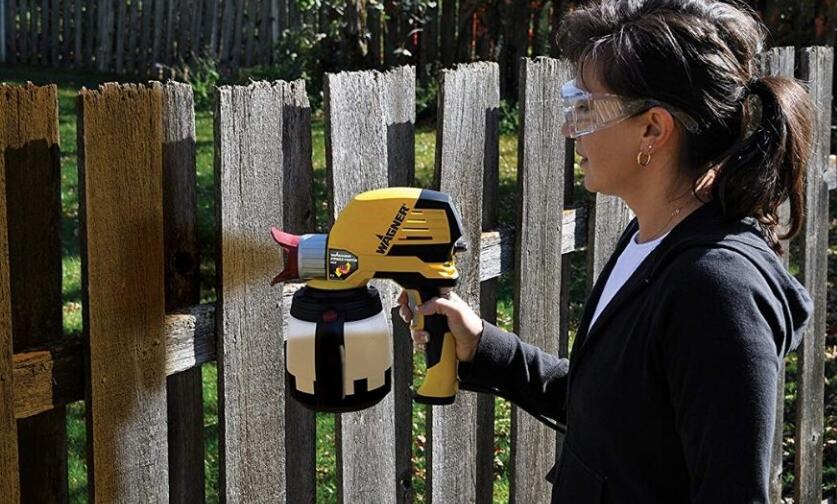
Everything There Is To Know About Paint Sprayers
As a home owner, we take great pride in how our home looks and the key to that to keeping everything nice and fresh is by performing regular touchups. But, how do you do that? You could resort to the old school method and whip out the paint brushes and rollers, but in today’s world, who actually has the time and the patience to do that? Not very many people.
If you’re one of those people, you’ll be pleased to learn that you can stream line the whole process and cut down the amount of time you spend on these projects significantly! How? With a paint sprayer, that’s how; and in this article, we’re going to cover a lot of ground when it comes to these incredible little tools.
Table of Contents
What Are Paint Sprayers?
A paint sprayer is as exactly as the name would imply. It is a tool that will use to make any painting or staining jobs quick and easy. It takes out the repetitiveness of painting and it will provide you with solid coverage as well as an even finish.
>> The best paint sprayers on the Market <<
What Can A Paint Sprayer Do (and Cannot Do)?
As far as DIY goes, you’re going to be tempted to use your sprayer for a variety of jobs; however, your sprayer isn’t going to be capable of everything you want to do. Here is a list of things you can use your sprayer for, and a list that you cannot.
Recommended For:
- Your sprayer can tackle large surface areas that needs a good even coat of paint. This could be the siding of your home, the interior walls, a piece of furniture, or even your car! You do want to make sure that you have plastic sheeting over anything that you do not want painted.
- Your sprayer can reach the details, nooks and crannies in furniture that your brush or roller may not be able to cover. The sprayer can also paint the corners inside of furniture without it becoming a gloppy mess.
- Your sprayer can make quick work of painting multiple surfaces a singular color, like cabinet doors for example. The sprayer is especially useful for applications like this because you can get it all done in a few strokes of the sprayer and have an even coating without the brush strokes.
Not Recommended For:
- You may not want to use your sprayer for small projects around the house. You can, however, find small sprayers that are designed for small jobs like crafts, but you will need to choose the right sprayer for those applications.
- Your sprayer is not going to be a good option if you’re concerned about the amount of paint you’ll be using or if you are worried about making a mess. A sprayer can be an effective tool, but it does have a tendency to be wasteful and messy.
- Your sprayer is going to require some prep time, so if you’re short on time and you need something done quickly, you’d be better off using your paint brusher or a roller.
- Your sprayer is going to have to be cleaned thoroughly after each use to ensure that it continues to work properly. If you’re someone who doesn’t like the cleanup, then a sprayer may not be for you. You can, however, find some models that will hook up to your garden hose and you can flush out the paint from the device.
What Kind Of Paint Sprayers Are There?
So we know that a paint sprayer is going to save you a lot of time on your projects, but did you know that there is more than one type of sprayer? Oh yes, there’s actually 5 types of sprayers, although two of them are more uncommon.
High Volume / Low Pressure
These paint sprayers use a continues stream of air that allows the droplets of paint to stick to your intended surface. The low pressure is going to create less of a mess and reduces the amount of paint that is wasted when you’re working inside.
These types of sprayers tend to work best with thin paints and stains, however if you purchase an industrial grade sprayer, it will be able to handle lacquers and varnishes. Keep in mind, these will be costly, so be wary of your budget and your project size.
>> Best HVLP Paint Sprayer for Spraying Latex Paint <<
Low Volume / Low Pressure Sprayer
Much like the HVLP sprayer, these sprayers operate at a lower pressure. The difference between them is that they also use a lower volume of air too. This is going to increase how efficient the sprayer is while decrease the amount of compressed air that is being used during operation.

Airless Sprayer
These sprayers work by pushing the product out at a high pressure. This will cause your paint to spread out like a fan. The final result will be an even coat of paint when you use the sprayer according to the manufacturer’s directions.
This type of sprayer is ideal for homeowners who want to make their exterior (fences, decking, and shutters) and their interiors (doors, ceilings, and walls) look fresh and clean. These types of sprayers can handle thicker paints with ease.
>> Hot Sale Graco Airless Paint Sprayers <<
Airless Spray Paint Roller
This device isn’t a sprayer per say. It is an attachment that you can add to your airless sprayer that will allow you to roll the paint onto a surface without needing to pour the paint out into a pain. These rollers work best with airless sprayers that have some kind of pressure control mechanism.
Diaphragm Paint Sprayer
These sprayers are a type of airless sprayers that use a hydraulic piston to draw hydraulic fluid from the pump and then compress it under a diaphragm. This is going to create enough suction to draw the intended product through the hose. These sprayers uses a pressure control valve that can regulate how much the piston works, and how much paint comes out.
How To Safely Use Your Sprayer Like A Pro
For those who have never used a paint sprayer before, you may be a little intimidated when you want to start your first project. To use your sprayer, follow these steps:
- Before you start using, make sure the area where you intend on painting is free from thing that you could trip on or that the hose could get caught around. Also, make sure that any surface that you do not want painted have been covered with plastic or drop cloths. This includes: furniture, windows, trim, floors, fireplace.
- Stir your paint according to the manufacturer’s instructions and then strain it so that nothing will clog your sprayer. Some machines will have an integrated filter for debris so that step may be skipped.
- Before you actually start spraying the paint, you’ll want to get the motion right. Practice moving the hose in long, straight passes. You don’t want to move too slowly because the sprayer is going to shoot the paint out pretty quickly. Try moving the sprayer like you would brush on paint, about 2 or 3 feet per second.
- Make sure the nozzle is perpendicular to the surface that you’re going to be working on, and make sure it is no closer than 10 inches from said surface. Keep this distance consistent while working, as even the slightest change could change the way your paint is applied. Also, keep a level hand so the paint goes where you want it to and not too far up or too far down. Consistency is crucial!
- Try to overlap each pass at least half of the coverage to ensure an even coating and there aren’t any light streaks in your paint.
How To Clean Up After Painting
After your paint job has finished, it’s time to clean your machine, especially to keep it in proper working condition.
You may be under the impression that cleaning your device is pretty straight forward, but there are some materials that are going to be harder to clean than others.

You spent a lot of money on your sprayer, so you’re going to want to clean it well.
Water Based Materials
If you are using a water based material in your sprayer, you will want to follow these steps:
- 1. Pour 4 gallons of water into a bucket and keep it at the ready.
- 2. Remove the suction tube from the material and allow it to drain for a few moments.
- 3. Remove the filter from the end of the suction tube and let it soak in clean water.
- 4. Put the suction tube into the water.
- 5. Remove the tip housing from the tip of the spray gun and soak that in water.
Now you can pump water through the sprayer to remove material from the unit as you can. You’ll want to make sure the pressure remains low during the cleaning process. Continue doing this until the water runs clear. Once it does run clear, you’ll want to clean the filters as well in warm soapy water.
Solvent Based Materials
The only difference between cleaning the machine that has used water based material and solvent based is that you will have to dispose of the solvent properly and have much more water on hand to cycle the solvents. You’ll run the solvent through the sprayer the same way you did with the water—run it through until everything runs clear.
How To Protect Yourself When Using A Paint Sprayer
When you’re using spray paint or spraying paint with a paint sprayer (now that’s a tongue twister!), you’re going to want to make sure you are protected and that you don’t get any toxic chemicals on you or in your lungs. You can protect yourself by:
- Using an activated carbon respirator to protect yourself from the paint and solvent (while cleaning) fumes.
- Wear gloves while painting and cleaning.
- Wear protective clothing over your own clothing for extra protection.
Should you get any paint or solvents on you, read the instructions on the paint or solvent’s packaging for instructions on what to do. In most cases, you can just wash the paint off with warm soapy water.
Accessories For Your Sprayer
The paint sprayer is designed to make your life easier, we already know that. However, there are accessories that can make things even more simple! Imagine that! These accessories sometimes will come with your sprayer, but sometimes you can purchase the accessory for your specific type of sprayer. First, let’s take a look at them!
Hoses
To maximize the usefulness of your sprayer, you’re going to want to have several different lengths of hoses available. These different hoses should range in size and length to best suit the jobs that you may do. For example, if you’re going to paint the hallway, you’ll want a shorter hose so you don’t get tangled up in it.
On the other hand, if you’re staining your fence, a long hose will be best so you don’t have to stop every so often to move the sprayer closer to you.

Extensions
You can find some rods can be attached to your sprayer so that it’ll be much easier to get a smooth surface on your project, whether you are trying to paint your ceiling, a deck, or any other hard to reach area. These extensions can also help your back so you’re not over extending yourself.
Filters
People often complain about clogging when they are working with a paint sprayer. Filters can prevent from any debris that may be in the paint from clogging the device. Also, the filters are designed to reduce the amount of splattering while painting.
Protectants
These are chemicals that can be added to your sprayer to protect it from corroding, freezing, or sticking. Also, they will increase the life of your sprayer so that it will continue to perform well for you.
Maintaining Your Sprayer
When you follow proper cleaning procedures like we mentioned before in combination with protectants, your sprayer should last. However, in terms of clogging, which is the main complaint people have about their sprayers, you’re going to want to be ahead of the game.
Usually newer sprayers will come with a tip guard installed that will prevent you or anyone else from accidentally injecting themselves with paint. This guard should be cleaned regularly (when you’re cleaning the machine, clean this also). You will also need to clean the tip while you are using the device, as the paint can collect here. Use a damp rag to remove the paint and never use your finger!
If your tip does become clogged while working, remove your finger from the trigger and then turn the tip 180 degrees. Point your sprayer at the ground or a scrap piece of wood or cardboard. Press the trigger until the clog has cleared. You may also have to manually clean the filter as well.
Popular Paint Sprayer Manufacturers
Before you sprayer, it’s always a good idea to do a bit of research. Like anything else you purchase, you’re going to want to make sure you’re buying a quality product. This is why we recommend sticking with popular manufacturers who are known for creating quality products.
Graco
The Graco company is an American manufacturer of fluid handling systems and products. The company is based in Minneapolis, Minnesota and it was founded in 1926. The company provides products for a number of markets ranging from anti-corrosion and gluing to painting and fluid transfer.
It should be no surprise that a Graco paint sprayer is among one of the top rated devices on the market. The company’s products are also distributed across the globe and can be found in retail stores worldwide.
>> Hot Pick Graco Magnum x5 Stand Airless Paint Sprayer <<
>> Best Sale Graco x7 HiBoy Cart Airless Paint Sprayer <<
Wagner
When it comes to a top names in paint and paint related products, Wagner is among the very top of that list. The company has an extensive line of Wagner paint sprayers, accessories, heat guns, rollers, and anything you could think of to make your projects that much easier. If you go to their website, they have an impressive library of outdoor and indoor projects for the enthusiastic DIYer.
>> Best Cheap Wagner HVLP Paint Sprayer <<
Critter Spray Products
Not every paint sprayer has to be a big fancy piece of equipment. In fact, they can be simple, economical, and easy to use! Case in point, the Critter Paint Sprayer. This particular product proves you can do a great job with just a small compressor and air regulator with their products.
Paint Sprayer Wrap Up
As a home owner, it can feel a little overwhelming when you suddenly realize that your home needs work. The shutters are faded, the deck needs to be stained again, and the walls in the house are covered in sticky finger prints.

The projects keep piling up and you loathe to think of how much time it is going to take to complete all of these tasks! You’re probably already saying goodbye to your weekends for the next few months just so you can get all of these tasks taken care of!
Oh dear friend, don’t say goodbye to your precious weekends just yet! The easiest solution to all of your problems is to get the family in on these tasks.
When everyone works together, the chores can get done so much quicker, right?
Unfortunately, getting the family to help is rarely an option and you’re left doing it by yourself. You can still make quick work of these tasks when you have a high quality but affordable paint sprayer. These tools can help you paint, stain, and finish all of your surfaces much easier than you have ever thought before.
There are several sprayers available on the market, and for many it can be a little confusing trying to figure out which product is going to work for their needs. Some projects you can get away with a smaller sprayer, while other projects like painting the house is going to need something much larger and stronger.
When you do get ready to use your sprayer, it is important that cover anything that you don’t want covered in paint and you can do that by using drop clothes or plastic while securing the edges with masking tape.
To keep yourself protected, you’ll want to wear protective clothing and masks because the paint fumes can be pretty toxic.
As you are spraying the paint, make sure you use even strokes that overlap each other by half so that you have an even coat and no streaks. Also, keep the nozzle the same distance (no less than 10 inches and no more than 12) from the surface. When you get too close, the paint will collect much quicker and may even cause it to drip down the wall, which is never a good look.
Finally, we want to point out that there are a lot of companies that make good paint sprayers on the market at different price points. When you’re trying to decide which sprayer is going to work for you, you want to think about how much money you are willing to spend on the product. You can find sprayers under $50, but you can find sprayers that reach above $500.

If you are having trouble trying to figure out what features you should be looking for in a sprayer, check out our buying guide for some help. Plus, we have five mini-reviews of some of the best rated sprayers that we think are certainly worth your consideration!
Resources:


